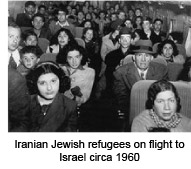the authorities to ensure cooperation. By 1957, only 15,000 Jews remained, and finally left in 1967, following the violent response to the Six-Day war.

For the Jews of Morocco and Tunisia, the stories are similar. Both communities had lived quietly in their countries since Biblical times occasionally suffered pogroms. Both communities experienced rioting and deaths following Israel’s independence and small numbers began immigrating to Israel in the early 1950’s where they were settled in camps. After Moroccan and Tunisian became independent in 1956, life for the Jews became intolerable. All Zionist activities, and religious gathering and worship were outlawed, homes destroyed and families divided. Economic boycotts crippled the once prosperous communities, and community aid organizations were dissolved. In 1949, there were riots in Northern Morocco and dozens of Jews were killed and injured. Jewish emigration was banned in Morocco in 1956, and in desperation, illegal and secret emigration began with the help of the Zionists. Between 1955 and 1957, over 70,000 Moroccan Jews arrived in Israel. In 1959 Zionist activities became illegal in Morocco. During these years more than 30,000 Jews left for France and the Americas. However, in 1963, the ban on emigration to Israel was lifted and another 100,000 emigrated there. By the early 1960’s, 90% of the Moroccan and Tunisian communities had emigrated, mostly to Israel. In all, over 330,000 Jews from these two countries joined their Jewish brethren in Israel.
Similar stories can be told across the Arab world. The oppressed Jews of Libya were mostly able to escape in the year following Israel’s independence. Riots began in 1945, killing 130 Jews and destroying the homes of 4,000. Over the next three years, synagogues were burned, stores looted and many people fell victim to the rioting. By 1951, 30,000 Jews left for Israel with the help of Israeli authorities, also carrying minimal possessions.

The ancient communities in Lebanon and Syria had lived fairly peacefully until World War Two. With rumors growing about the Israeli partition, tensions were fueled. Syrian Independence in 1946 sparked anti-Jewish riots that left the community ravaged and much of the community fled. Following property freezes, taxation, arrests and discrimination, most of the 30,000 Jews left to find new lives. In Lebanon, despite Christian – Arab rule, there was an undercurrent of unrest. By 1967, only 100 or so individuals remained from a once 30,000 strong community.
Of the estimated 850,000 Jews who had lived in Arab countries, today only around 40,000 remain in small, nervous clusters. In the early years of the State of Israel, over 600,000 Jews arrived from Arab lands, with no refugee assistance from the world. When the Jews fled, they didn’t come with their documents of property to reflect the enormous assets that hundreds or thousands of years of residence in these countries had accrued to them.